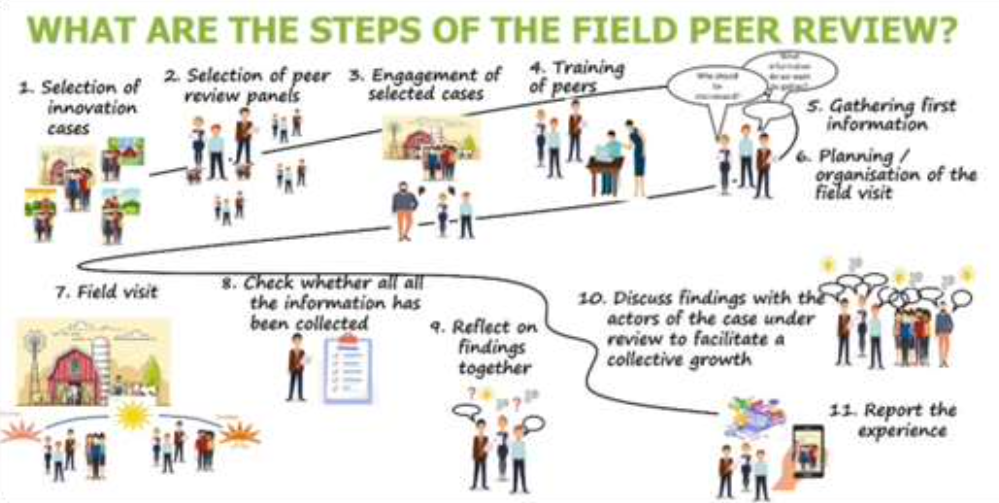Rationale
An innovation advisor needs to possess a specific attitude and personality, as well as expertise regarding content, methods and management. Competencies concerning ‘attitudes’, are of a personal nature and, therefore, they prove to be difficult to be transmitted through a traditional training oriented to knowledge transfer. Often, these capacities are developed through experience on the field. Moreover, methods and tools for facilitating innovation processes are often new and result from the experiences of actors. Therefore, it is important to socialise these experiences and network them in order to benefit from their diversity and foster experiential learning.
Solution
Within the i2connect project the organisation and exchange of practices and experiences between advisors providing support services for innovation processes has been encouraged through the organisation of field peer reviews.
The Field Peer Review consists of the review of the interactive process of an operational group (OG) or another multi-actor innovation case, with a particular focus on innovation support functions, by colleagues (peers) from another OG/innovation case, with the purpose of observing and analysing practices and learning from the way how innovation has been realised by others, whilst providing recommendations to the reviewed case to improve the interactive process.
Peers are people (advisors, farmers, researcher) that work in a similar context and/or institution with the persons whose performance is assessed and have specific professional experience and skills in the field. Consequently, they can bring into the process "direct" knowledge about the matter under review whilst providing the external vision of someone from a different organisation ("external insider").
The task of the Peers is to achieve an understanding of the subject/situation under assessment (learning function) and to provide critical feedback to their colleagues, thus allowing to improve their practices.
Therefore, the peer review combines assessment and learning approaches, allowing for more significant development of innovation practices by encouraging more critical reflection on innovation processes.
Considering these issues, peer review methodology can have significative practical implications, being able to be developed as:
- a strategy within public funded innovation programmes to foster partnerships’ own development through the ideas obtained from watching colleagues, help improve innovation processes, and create a system of mutual accountability and learning within the AKISs,
- assessment tools for advisory services.
In practice...
The Field Peer Review is carried out through an onsite visit, observation and interviews with different actors’ groups.
A peer review procedure and an analytical tool to be used for data gathering and assessment have been set up to allow the reviewers to focus on the interactive process, which generally is hardly addressed compared to innovation per se, going far beyond what may be considered a mere exchange of practices.
The analytical framework is based on a comprehensive body of literature concerning advisory functions and interactive innovation dynamics and includes more than 150 evaluation questions. In particular, the evaluation questions address three main issues:
- support services that are or should be offered, by whom and through which methods and tools,
- the effectiveness of innovation support and its contribution in helping the process to move on,
- the conditions, both internal (advisor’s characteristics) and external (environment), that enable the specific actor(s) to support the innovation process.
The questions are included into a user-friendly tool and organised according to the phases of the innovation process. Information-gathering questions are complemented by other questions aimed at leading reflection on the collected information and their triangulation. This reflection activity is aimed at developing critical capacities, thus supporting a peer learning process. The peer review procedure of innovation cases consists of 4 main phases:
- peer reviewers’ selection and training,
-
- organisation of the field visit,
- field visit,
- peer review recommendations and reporting

- The composition of the field review team depends on the type of organization and coordination of the peer review. For instance, a peer review could be carried out by a team of peers chosen within one OG/innovation group who visit and review the innovation process carried out by another OG/innovation group. It is crucial that peers understand how to conduct the Field Peer Review properly: who to interview, how to use the questions, the desired outcome. Therefore, a short training is needed, to raise their awareness on the task to be played and provide them with the necessary instruments.
- Before the visit, Peers are provided with preliminary information concerning the case under review, through documents or interviewing a key actor. The preliminary documents/interview aim to provide the Peers with an overview of the practical case in its complexity, including the activities carried out and the roles of each actor within the case. Through the interview all the information necessary for the preparation of the Peer Visit are collected. Based on the documents received and the preliminary interview, the Peers define: i) the subjects to be interviewed (specific actors or typologies); ii) the questions to be asked to each actor or group of actors (following the analytical tool): iii) the methods of collecting information (e.g., how many individual / group interviews, guided visits, etc.); iv) the estimated time for the visit
- The Field Peer Visit is the core activity of the Peer Review procedure: Peers visit the practical case and carry out an assessment, which focuses on roles and function of advisors in supporting innovation processes, the effectiveness of this support and the enabling context.
The review approach is built on interviews (individual or group), focus groups and observations. Practical case actors and stakeholders are interviewed preferably in groups of about 5 people for 90 minutes, but individual interviews are also possible if they better fit the goals of the review. The questions for each group (not more than 7-8 questions, otherwise, due to time limits, not everyone will be able to answer each question) are chosen according to the analytical tool. At the end of the Visit the Peers provide feedback to the evaluated practical case.
The duration of the visit depends on the complexity of the reviewed practical case (type and number of involved actors, innovation typology, etc.) and accessibility of the location (in case of Peer Review on the Field). It is advisable to plan rather short visits because 1) a Peer Review upsets the routines of the actors in the practical case and 2) Peers cannot be absent from work for too long a period. Therefore, Peers' Visit should take no more than two-three days.
The core element of a Peer Review is the professional assessment provided by the Peers.
During the Visit, Peers review and discuss the results of each activity immediately after its conclusion and organize peers' reflection meetings. They are asked to analyse, discuss and understand the information gathered, to evaluate its reliability and relevance, to discuss the different perspectives and opinions within the Peer Panel and to agree on common conclusions.
Peers share observations and try to understand the innovation processes. The analytical tool drives the reflection towards the final assessment.
- At the end of the Peer Review, the Peers schedule a feedback session during which they share their results with the reviewed practice case. This allows for a communicative validation with direct comments from the reviewed case and a request for further explanation - as well as an exchange between the Peers and the reviewed case on crucial aspects of the process.
Finally, peers make recommendations. These are presented and discussed in an open exchange between the Peers and the Practical Case representatives, to allow the discussion should focus on exchange and mutual learning.
The Field Peer Review should conclude with a report, but given the nature of Peers, it is appropriate to think of simpler and more practical solutions, such as videos.
Practical implications for replicability
Field Peer Review is carried out through field visit, observation and interviews with different actors’ groups of an interactive innovation case.
It can be organized in different ways, depending on the available networks, resources (staff and finances), and knowledge needs and requirements.
A single Field Peer Review can be run, for example, by an advisory body or innovation support service provider, who creates a network with other advisors/IIS providers spontaneously to review their own cases.
Reciprocal Field Peer Reviews could also be organized between two advisors/advisory bodies/ISS providers, looking for stronger and more constant cooperation.
More appropriately, Field Peer Reviews could be implemented at national or regional level within the CAP strategic plans, or be carried out in a network which already exists (e.g., CAP / EIP-Agri network) or has been created for the purpose of carrying out Field Peer Reviews. This allows for common preparatory activities such as peer selection, training, matching peers with the cases to be reviewed, etc. This requires the "appointment" of a coordinating body to ensure high quality Peer Reviews and effective coordination of the common process and procedures.
Benefits
A possible implementation of a national or regional Field Peer Review programme between operational groups within the CAP strategic plans would bring numerous benefits:
- engage OGs in a mutual learning process with Peers,
- create networks and cooperate with other OGs,
- promote competence and skills development,
- improving information on interactive innovation projects funded through the EAFRD,
- assessing the quality of interactive innovation processes and support services provided, at a relatively low cost,
- highlighting strengths and demonstrating good practice,
- increase accountability to stakeholders,
- identify shortcomings and weaknesses,
- receive advice to improve ongoing interactive innovation processes,
- promote the development and quality of co-creation approaches and quality assurance. Therefore, this tool can support managing authorities and possibly evaluators during the design, monitoring and evaluation phases of policies and interventions supporting innovation.
Further information
- Guidelines and tools for decision makers and managing authorities, Deliverable 3.4 i2connect project https://i2connect-h2020.eu/resources/communication- materials/reports-and-project-outputs/

